Input interpretation

octane
Chemical names and formulas
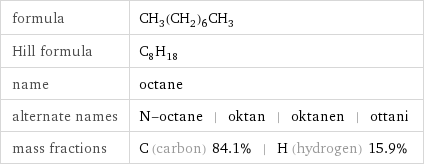
formula | CH_3(CH_2)_6CH_3 Hill formula | C_8H_18 name | octane alternate names | N-octane | oktan | oktanen | ottani mass fractions | C (carbon) 84.1% | H (hydrogen) 15.9%
Lewis structure
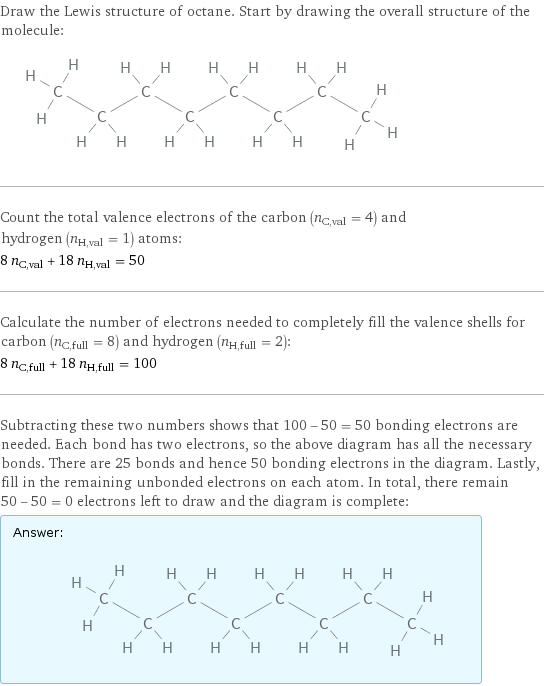
Draw the Lewis structure of octane. Start by drawing the overall structure of the molecule: Count the total valence electrons of the carbon (n_C, val = 4) and hydrogen (n_H, val = 1) atoms: 8 n_C, val + 18 n_H, val = 50 Calculate the number of electrons needed to completely fill the valence shells for carbon (n_C, full = 8) and hydrogen (n_H, full = 2): 8 n_C, full + 18 n_H, full = 100 Subtracting these two numbers shows that 100 - 50 = 50 bonding electrons are needed. Each bond has two electrons, so the above diagram has all the necessary bonds. There are 25 bonds and hence 50 bonding electrons in the diagram. Lastly, fill in the remaining unbonded electrons on each atom. In total, there remain 50 - 50 = 0 electrons left to draw and the diagram is complete: Answer: | |
3D structure

3D structure
Basic properties
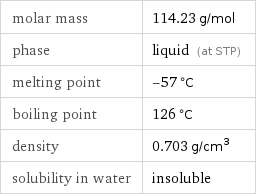
molar mass | 114.23 g/mol phase | liquid (at STP) melting point | -57 °C boiling point | 126 °C density | 0.703 g/cm^3 solubility in water | insoluble
Units

Liquid properties (at STP)
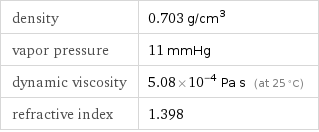
density | 0.703 g/cm^3 vapor pressure | 11 mmHg dynamic viscosity | 5.08×10^-4 Pa s (at 25 °C) refractive index | 1.398
Units

Thermodynamic properties
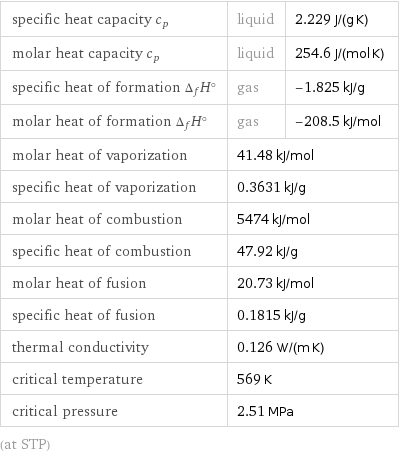
specific heat capacity c_p | liquid | 2.229 J/(g K) molar heat capacity c_p | liquid | 254.6 J/(mol K) specific heat of formation Δ_fH° | gas | -1.825 kJ/g molar heat of formation Δ_fH° | gas | -208.5 kJ/mol molar heat of vaporization | 41.48 kJ/mol | specific heat of vaporization | 0.3631 kJ/g | molar heat of combustion | 5474 kJ/mol | specific heat of combustion | 47.92 kJ/g | molar heat of fusion | 20.73 kJ/mol | specific heat of fusion | 0.1815 kJ/g | thermal conductivity | 0.126 W/(m K) | critical temperature | 569 K | critical pressure | 2.51 MPa | (at STP)
Phase diagram
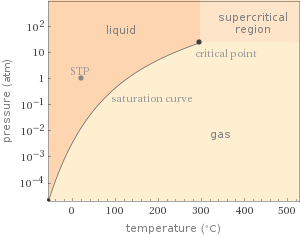
Phase diagram
Units

Basic drug properties

approval status | experimental | small molecule
Hydrophobicity and permeability properties
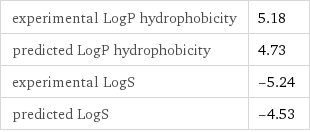
experimental LogP hydrophobicity | 5.18 predicted LogP hydrophobicity | 4.73 experimental LogS | -5.24 predicted LogS | -4.53
Chemical identifiers
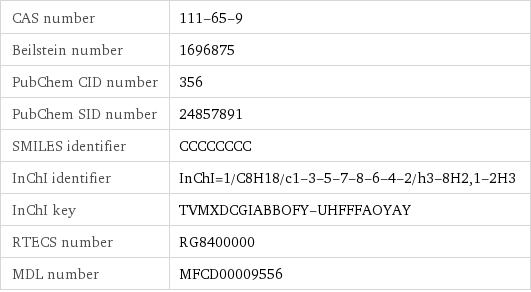
CAS number | 111-65-9 Beilstein number | 1696875 PubChem CID number | 356 PubChem SID number | 24857891 SMILES identifier | CCCCCCCC InChI identifier | InChI=1/C8H18/c1-3-5-7-8-6-4-2/h3-8H2, 1-2H3 InChI key | TVMXDCGIABBOFY-UHFFFAOYAY RTECS number | RG8400000 MDL number | MFCD00009556
NFPA label

NFPA label

NFPA health rating | 1 NFPA fire rating | 3 NFPA reactivity rating | 0
Safety properties
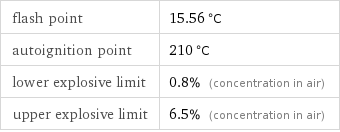
flash point | 15.56 °C autoignition point | 210 °C lower explosive limit | 0.8% (concentration in air) upper explosive limit | 6.5% (concentration in air)
Toxicity properties

short-term exposure limit | 1800 mg/m^3 threshold limit value | 300 ppmv
Units
